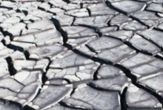Southwest Forecast: Expect 90 Years of Drought

Human-induced change in Earth's atmosphere will leave the American Southwest in perpetual drought for the next 90 years, a new study finds.
Conditions in the southwestern states and portions of northern Mexico will be similar to those seen during a severe multiyear drought in the southwest during the 1950s and the drought that turned the Great Plains into the Dust Bowl in the 1930s.
The southern United States lies in a climatic region called the subtropics, which is dry because “the atmosphere moves water out of those regions,” explained study team leader Richard Seager of Columbia University's Lamont Doherty Earth Observatory.
The moist air is transported to temperate regions at higher latitudes. The study, published in the April 5 issue of the journal Science, found that as greenhouse gases warm the air, it can hold more moisture, so the atmospheric flow moves more water vapor out of subtropical zones and into higher latitudes. The dry areas then become drier, and the wet become wetter.
This flow, known as the Hadley cell, features rising air over the equator and descending air over the subtropics, which suppresses precipitation.
“And that Hadley cell, in a warming world, expands poleward,” Seager said, bringing the U.S. Southwest more under the influence of the descending air.
Similar changes in the atmosphere produced past droughts and conditions such as the Dust Bowl, but the study found that the ultimate cause of historic droughts was natural, unlike this projected drought. During those droughts, La Niña, El Niño’s cool-water counterpart, brought cooler ocean temperatures to the equatorial Pacific, which resulted in drier conditions over North America.
Get the world’s most fascinating discoveries delivered straight to your inbox.
The researchers used climate models to determine the level of drought based on the amount of evaporation at the ground subtracted from the amount of precipitation that falls at the surface.
The balance between these two processes is what maintains rivers and groundwater flow. As less water is available, water resources become jeopardized.
“The lifeline there is the Colorado River,” Seager said, and it and other rivers are already stressed by the 10th year of drought in the Southwest.
As populations in the Southwest increase, governments will have to make adjustments to reduce water usage, but Seager and others unsure just what those changes should be.

Andrea Thompson is an associate editor at Scientific American, where she covers sustainability, energy and the environment. Prior to that, she was a senior writer covering climate science at Climate Central and a reporter and editor at Live Science, where she primarily covered Earth science and the environment. She holds a graduate degree in science health and environmental reporting from New York University, as well as a bachelor of science and and masters of science in atmospheric chemistry from the Georgia Institute of Technology.


